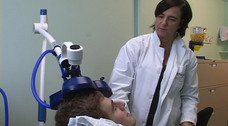2010-05-17

Transcranial Magnetic Stimulation sounds more like a Sci-fi application than a healthcare treatment. But TMS—as it is most commonly referred to—is the newest kid on the block at the Douglas Mental Health University Institute when it comes to treating depression.
How does it work… and why?
According to Dr. Berlim, TMS, which was used for the first time for clinical depression in 1995 in the US, requires a very simple device. “It has a capacitor, which means it has an equipment inside that stores electricity,” he says. “Then a metallic coil, which looks like a figure-of-eight, releases the stored energy in very brief and fast pulses in certain regions of the patient’s head.”
Parameters, such as the number of pulses, their intensity and the interval between pulses, are chosen by the professionals. These parameters are determined using current safety guidelines.
The question is, why does it work? “Well, this is not yet fully understood,” says Dr. Berlim. “What we do know is that these electromagnetic pulses are able to induce electrical currents in the brain, which is an electrical organ that communicates significantly through electrical pulses. Due to this we are able to modulate the activity of the neurons of the brain based on the electrical currents. The how is still under investigation.”
Since the machine arrived in mid-2008, it has only been used in a pilot study with depression. The idea was to learn how to use the machine, assess its usefulness, and see what side effects accompanied it. “We really wanted to be able to try the machine before making it available to the community,” says Dr. Berlim.
Who is it for?
Typically TMS is indicated for patients suffering from current major depression, who have tried unsuccessfully at least two antidepressants, or for patients who cannot tolerate the medications prescribed for depression.
“But this is not a treatment for everyone,” stresses Dr. Berlim. “The rate of improvement is probably around 30 to 50 percent. And it takes up to four to six weeks of daily treatments for symptoms to improve. We have also found that as depression gets more severe, the rate of response usually decreases.”
For some people, the positive effect can last up to a year. With others, however, maintenance TMS is required after only a few months. This treatment is not as intensive, only once or twice a week, but it has sometimes to be done indefinitely.
“When we are finally ready to offer TMS to our community as a treatment we will ask that patients have a medical referral,” says Dr. Berlim. “This means they will need a medical consultation from a general practitioner or ideally a psychiatrist. Then I will meet with the patient, assess his/her clinical history and confirm the diagnosis of major depression. I will then assess safety issues with TMS, which is primarily that the patient cannot have a personal history of epilepsy/convulsion.”
Benefits and side-effects
According to Dr. Berlim, the treatment is very safe. “The worst side effect that can happen—and this happened in the past before the safety guidelines were developed in 1998—is a convulsion,” he says. “Patients say that with every magnetic pulse they feel a ‘click’ in their heads, but after a few days they usually get used to it. It can also contract the muscles in the head so if you have a history of tension headache it could trigger headaches, which gets better with ibuprofen or aspirin.”
TMS is also being tried as a treatment for several psychiatric and neurological illnesses, such as Parkinson’s disease, Alzheimer’s, anxiety disorders (for example, obsessive compulsive disorder, post-traumatic stress disorder and generalized anxiety disorder), schizoprenia and eating disorders. These are much more recent areas of research, but it is Dr Berlim’s plan to be able to offer TMS for some of these clinical conditions in the near future.
The only illness TMS has been approved for by the FDA so far, however, is major depression.
When the new Douglas Brain Imaging Centre is ready—expected to be completed by early 2011 —there will be a specific suite for TMS, which will house two to three devices,. Also in the centre will be located several different kinds of methods of investigation of the brain, including neuroimaging and electroencephalography, which will complement one another in improving patient care and outcomes.
Currently, the Douglas is the only healthcare facility in Quebec that uses TMS specifically for treating psychiatric illnesses.


